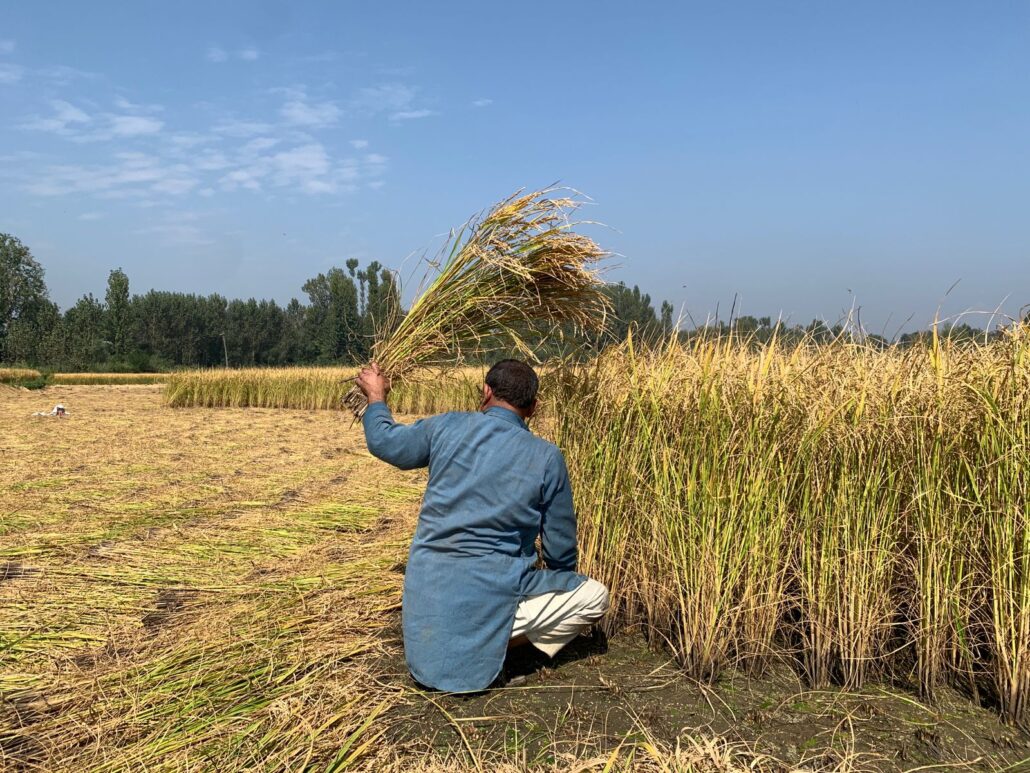
“Batih Daedi Marekh Kaeshir Musalman, Hai Toofan Hai Toofan” (Kashmiri Muslims are now being deprived of food grains, what injustice, what tyranny!).
This Wanwun was recited by the local women who took part in the protest outside a ration depot in Srinagar’s Mehjoor Nagar area recited in traditional Wanwun’. Wanwun, the traditional Kashmiri songs, also sung during Kashmiri weddings have been used as a form of protest by locals ever since the onslaught of successive oppressive rulers.
It was this Tuesday that the residents of Nowhatta, Srinagar locked down a ration depot, outraged at the reduction in the food allocation quota for Kashmir valley residents. According to the residents, the quota per person was initially reduced from 15 kilograms to 10, and has now been reduced further to 5 kilograms.
“When we were already suffering greatly due to water and power shortages, inflation, and unemployment, the government has now added to our woes by making only 4kg ration available for a consumer at a ration depot,” Mohammed Ismail, an old aged protester wearing a woolen cap, a muffler, and covered in at least four layers of clothes said, as temperatures in the Kashmir valley dropped below freezing.
Several protests have been reported across the Kashmir valley in recent days.
With the government curtailing food grain supplies through its public distribution system to five kilograms per soul per month, Kashmir is experiencing a severe food crisis, causing panic and anger among the population. In Kashmir, people are astonished as to how they will survive on a monthly rice quota of five kilograms per person. Rice is the valley’s staple food and primary source of carbohydrates.
Kashmiris’ affinity for rice extends beyond the borders of Kashmir. “If I see a Biryani shop on the way back after finishing the fast food, I always tell my non-Kashmiri friends, let us go and have food now, who always look at me with amazement after having had so much fast food. We are not done until we eat eating rice. Rice has always been our mainstay. Rice is our synonym to food,” my friends who study outside of Kashmir tell me.
In fact, the love for rice and how it shaped Kashmir’s modern political landscape has become an inseparable part of our oral storytelling tradition over the years. The story dates back to 1953, when Bakshi Ghulam Mohammed staged a coup against Sheikh Mohammed Abdullah, who had launched a mass revolt for Jammu Kashmir’s independence. Bakshi took power after Sheikh was imprisoned. People had been out on the roads for months in search of their leader, Sheikh. Mass arrests occurred in Kashmir in response to Bakshi’s takeover. Bakshi, the architect of “Naya Kashmir,” gained enormous popularity among people from all regions, however, after he provided rice for 4 Anna per Kilogram. People claim that the protests subsided after rice was provided at no cost.
“He (Modi) has done nothing for us. He just claims to be helping the people of Jammu Kashmir, but in reality he is snatching our work, our livelihood, our food from us,” Mohammed Ismail told The Kashmiriyat.
Why are Kashmiris protesting
Kashmiris believe that the allocated rice quota (5KG per person per month) is insufficient to meet the population’s needs. Kashmiris who were getting 15 kilograms of food grains will now receive merely 5 kilograms of food grains.
The total allocation of food grains (rice and wheat) for the Kashmir division in July 2020 under the three schemes — NFSA, JKFES, and PMGKAY — was 585671. quintals. In August 2021, this allocation dropped down to 510000 quintals.
Under the Mufti Mohammed Sayeed Food Entitlement Scheme five (5) kilograms of rice and five more under Pradhan Mantri Garib Kalyan Anna Yojana (launched in the aftermath of COVID 19) were provided per person in Kashmir in addition to the five kilograms provided under the NFSA.
Initially named Mufti Mohammed Sayeed Food Entitlement scheme was renamed as as Jammu Kashmir Food Entitlement Scheme (JKFES) after the PDP BJP Government fell in June 2018 and was later shut in September 2022.
The closure of the Jammu Kashmir Food Entitlement Scheme (JKFES) in September 2022 reduced food grain allocation to 455000 quintals. In December 2022, Government withdrew the Pradhan Mantri Garib Kalyan Anna Yojana and the allocation of food grains to the Kashmir valley in January 2023 dropped to 283051 quintals.
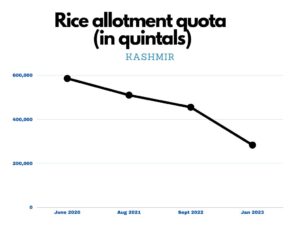
The signs of decreasing allocation began to emerge in early 2021, but the numbers were ignored until December 2022 when the impact of the reduced allocation quota was felt for the first time by local residents.
During this period, over 60 Lakh Kashmiris were allocated 210849.89 quintals of food-grains under the National Food Security Act alone. In October same year, the quantity of the food dropped to331221.51 quintals marking a deficit of 120371.62 quintals.
30457.95 quintals of rice (50595.74 quintals in November 2020) were allotted under the Antyodaya Anna Yojana (AAY) category for the month of January. 1321.60 quintals of wheat were allocated under the same category, while the figure for November 2020 was 1488.11 quintals.
For the same month, 70701.04 quintals of rice (109239.08 quintals in November 2020) were allocated under the Non-Priority Household (NPHH) category.
In the same category, 3713.51 quintals of wheat were allocated for the month of January 2021, while 5749.43 quintals were allocated in November 2020.
The Indian government announced in December 2022 that under the NFSA, rations would be provided free of charge for one year beginning January 1, 2023 to cushion the poor from the effects of the PMGKAY closure, which will end on December 31, 2022; however, the decision of “free distribution” has failed to amuse people in Kashmir, where the quantity has become a cause for concern.
“We don’t want any freebies. We are not vagrants begging for assistance. We will buy rice at standard prices. Since the BJP came to power, it has been causing problems for the people in various ways. The rich will never understand how much the poor have suffered in the years since the BJP took power, and after abrogation, our jobs are gone, and there is massive inflation. Keep the free grain (Modi Ji), we will purchase rice, “a protestor in Srinagar’s Mehjoor Nagar said.
They also condemned the government’s sugar embargo.
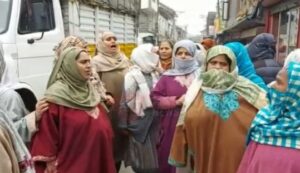
He claimed that the Kashmiri labour class has suffered the most. It is insufficient for our requirements. Kashmiris consume rice twice daily. By what measure is five kilograms enough for a month for one person? inquired the female protesters. “This is simply injustice,” they exclaimed. The protests, however, have remained confined to the urban areas as of yet, which officials fear will spread to other parts of the valley.
According to a Consumer Affairs and Public Distribution (CAPD) official, who wished to remain anonymous, rice has been stocked in Kashmir’s upper reaches for four months. According to the old scheme, the storekeepers have enough rice. “However, a crisis may soon strike these areas because the available supply will run out by the end of February. Some people have already sought answers here,” the CAPD official from a Baramulla village told The Kashmiriyat.
He asked the people to not harass the storekeepers because they have no control over the quantity of rice served to consumers.
“Even though under NFSA ration will be provided free from January 2023 to December 2023, but nothing will be given in addition to this ration, this certainly is a problem. People will have to cater to their needs and for that they will go to open markets where rice is available at exorbitant rates,” he said.
He stated that in July 2020, Kashmir received nearly 6 lakh quintals of rice, while in January 2023, we received nearly 3 lakh quintals of rice, a 50% decrease. This is undoubtedly a problem in Kashmir, where wheat and flour are consumed in trace amounts and rice is the common diet.
According to CAPD officials, various representations have been sent to the government requesting an increase in the additional rice quota for the people of the Kashmir valley. “We sought an increase of at least five kilograms for each individual in the valley,” he told The Kashmiriyat.
Local production falling steadily
Our collective memory is shaped by the years of 2008, 2010, ’16, when the valley’s administrative system collapsed in the aftermath of civilian protests and people from villages flocked to urban areas for months, providing an abundant supply of rice, vegetables, and other eatables to urban residents. Despite other sectors of work being crippled by the 2014 floods and COVID 19, the agricultural sector managed to stay afloat. Although agriculture has sustained our economy, it has come under severe strain due to a variety of reasons.
The rice fields in Kulgam district of Kashmir are a delight to the eyes. Below the open blue skies lies the golden spectrum of paddy fields stretched to miles. The techniques used to build these fields help to preserve and nurture beautiful scenery as well as a variety of living things.
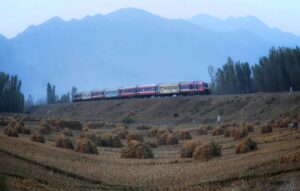
This was once the rice bowl of Kashmir, however, things have changed over the years. Over the years, nearly half of the agricultural land is lost to non-agricultural uses. In 2002, the south Kashmir district had 44,000 hectares of land under paddy cultivation, in a period of two decades, the stretch of agricultural land had shrunk to 22,000 hectares, officials from the Agricultural Department said.
With the administration legalizing the land change use from agricultural to non-agricultural purposes for the “growth of industrial sector” and “generation of employment”, the agricultural land is expected to shrink further in the Kashmir valley.
In December 2021, the Administrative Council (AC) which met here under the chairmanship of the Lieutenant Governor, Manoj Sinha, approved the regulations framed by the board of revenue for conversion of agricultural land for non-agricultural purposes. These regulations were necessitated after the legislative changes in the land revenue act post-reorganization of the erstwhile state.
The Assistant Commissioner (Revenue), Sub-Divisional Magistrate and Tehsildar concerned have been entrusted with the responsibility of monitoring the implementation of these regulations within their respective areas of jurisdiction. Besides, it will be the duty of every Agriculture Extension Officer to report cases of violation to the revenue officers and any neglect on this account can attract disciplinary action for dereliction of duty.
Jammu Kashmir administration said that the decision is aimed at ensuring production of sufficient quantity of food grains, besides promoting orderly growth of industrial and services sector in this Union territory and creation of employment.
Agriculture always has been the backbone of the Kashmiri economy. The sector employs more than 70 per cent of our workforce, directly and indirectly. Furthermore, more than 72% of Kashmiris live in rural areas, making their connection with agriculture unavoidable.
Official data shows that Kashmir had 4, 67,700-hectares of agricultural land in 2015 which had dropped drastically to 3, 89,000 hectares in 2019, out of which 78,700 hectares of land have been been converted from Agricultural to Non-Agricultural purposes. The deficit in food production in the Kashmir region has already reached 40 per cent, while the deficit in vegetable production at 30 per cent and the production of oilseed has dropped by 69%, putting food security in the Kashmir region at risk.
Furthermore, natural factors such as late snowfall, insufficient rains, and global warming have all contributed to a drop in Kashmir’s reduced agricultural produce. In April 2022, officials issued an advisory advising farmers not to cultivate paddy crops due to low discharge of water from nearby water bodies, while admitting that water scarcity is likely to affect Kashmir parts in the middle of summer due to a lack of rainfall and early melting of snow.
The agricultural sector in Kashmir suffered massive damage during the last few years, however, there is an absence of insurance schemes for crops, which Jammu Kashmir Kisan Tehreek feels has made people switch their paddy fields into either apple orchards, brick kilns or convert their agricultural land into non-agricultural production.
Majority of farmers in Kashmir believe that growing paddy is not profitable enough. They claim that the meagre production of their paddy crops allows them to barely feed their families. “We are a family of six with an orchard on seven marla of land. Our orchard produces around 300 boxes of apples per year; previously, we produced approximately one to two quintals of rice from the same land, which was insufficient to even feed our own family, so we decided to convert the paddy land into horticulture land,” Abdul Rashid, an apple orchard owner from Baramulla.
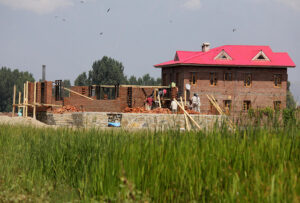
An office bearer of Jammu Kashmir Kisan Tehreek (wishing to remain anonymous) feels that the government has failed to take any initiative to prevent the farmers from switching their land to non-agricultural purposes. “Although the government has imposed MSP in several states, no such initiative has been undertaken in Kashmir. Furthermore, the crop insurance policy was agreed upon by the government, but it is limited to one district and only for certain crops,” he told The Kashmiriyat.
Nearly 400 farmers have benefited from agriculture related insurance schemes in Anantnag, Kashmir’s only district where the Pradhan Mantri Fasal Bima Yojana (PMFBY) is operational, according to Ejaz Hussain, Chief Agriculture Officer, Anantnag. “This season, nearly 400 affected farmers in the district received compensation totaling 47 lakh rupees.”
He stated that the crop insurance scheme only covers three crops: maize, rice, and oil seed. He stated that the scheme does not currently cover any other crops.
Farmers in Anantnag who grow any of the three crops can sign up for the insurance scheme through the Fasal Bima Yojana online portal and receive compensation if they are affected by natural disasters, according to Hussain, adding, “The scheme will be expanded to other districts soon. “As of now, the insurance scheme is extended to three districts of the Jammu region and one from the Kashmir division,” he said.
Because of the decline in local rice production, Kashmir has become heavily reliant on government-supplied food grains. “The government should either meet the needs of the agricultural sector, which it has neglected, or supply enough rice. Kashmir does not need rice or food grains. We will purchase rice at market prices,” te farmer leader stated.
As local rice production has declined, Kashmir has become increasingly reliant on government-supplied food grains. “The government should either meet the needs of the farming sector, which it has abandoned, or deliver adequate rice. Kashmir does not need freebies. We will purchase rice at market prices,” he said.
“It appears to be a deliberate attempt to ‘uniformize’ Kashmir by forcing the people to eat flour in addition to rice like in several other states. They ignored the regional topography, as they did with the educational calendar, and they are now avoiding local voices, our traditions, ” the office bearer of Jammu Kashmir Kisan Tehreek stated.
